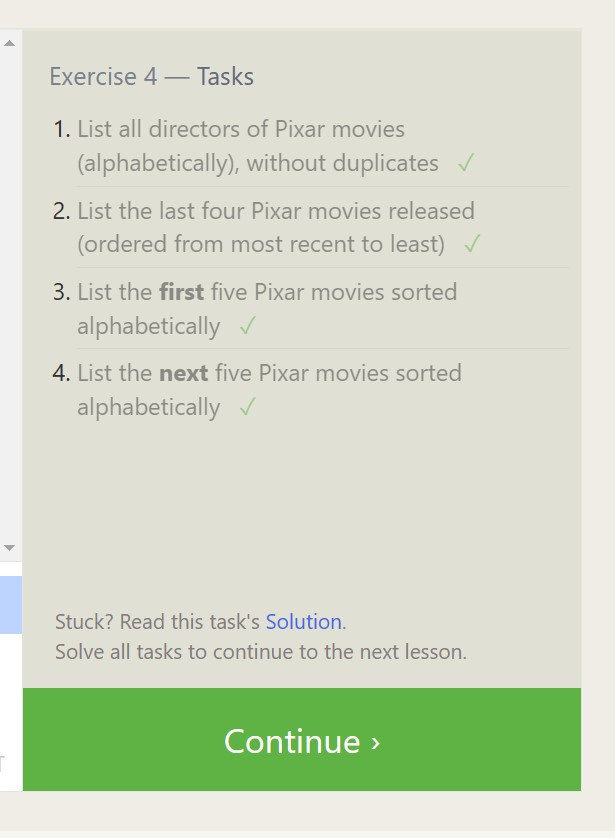reading-notes
Code Fellows 401
Prework Notes
Introduction to SQL










Git Practice
Practice in the Terminal
The Linux Command Line:
- Explanation of what the command line is and its advantages over a graphical user interface
- Basic commands such as “ls” (list files and directories), “cd” (change directory), “pwd” (show current directory), “mkdir” (create a new directory), and “rmdir” (remove a directory)
- How to navigate the file system using the command line
- Basic command line editing and history features
Navigation:
- Using the “cd” command to navigate the file system
- Understanding the concept of “absolute” and “relative” file paths
- Using wildcard characters to match multiple files at once
- Understanding the “..” and “.” notation for navigating directories
About Files:
- Explanation of the different types of files in a Linux system, including regular files, directories, symbolic links, and special files
- Using the “ls” command to view file properties, such as permissions and timestamps
- Changing file permissions using the “chmod” command
The Manual:
- Explanation of the “man” command and its use for viewing manual pages for different commands
- Understanding the structure of manual pages and how to navigate them
File Manipulation:
- Copying, moving, and renaming files using the “cp,” “mv,” and “rename” commands
- Creating and editing text files using the “touch,” “nano,” and “vi” commands
- Using the “rm” command to delete files and directories
- Compressing and uncompressing files using “gzip” and “tar” commands
Python Practice
Python seems to be more intuitive that JS in many regards. I’m excited to start working with a little more structure. ;)
Growth Mindset
- Building software doesn’t mean you get better at programming every day
- Improving your hard technical skills makes all the software you build better
- It doesn’t happen by accident, it requires deliberate practice
- Deliberate practice is activities designed to effectively improve specific aspects of an individual’s performance
- Deliberate practice requires pushing yourself just outside your comfort zone, being repeated often, receiving feedback on results, being highly demanding mentally, being difficult, and having good goals.
Data Structures
- The 8 common data structures that every programmer must know are:
- Arrays Arrays are a collection of elements of the same type, stored in contiguous memory locations, and can be accessed by index.
- Linked Lists Linked Lists are a collection of elements called nodes, each node contains a value and a reference to the next node in the list.
- Stacks Stacks are a last-in-first-out data structure, that means that the last element added to the stack is the first one to be removed.
- Queues Queues are a first-in-first-out data structure, that means that the first element added to the queue is the first one to be removed.
- Trees Trees are a hierarchical data structure, it has a root node and child nodes, each node can have multiple child nodes.
- Heaps Heaps are a specific kind of tree, they have a specific ordering property, either min heap or max heap.
- Hash tables Hash tables are data structures that store key-value pairs, it’s used for efficient searching and insertion operations.
- Graphs Graphs are a non-linear data structure, it’s a set of vertices and edges, it’s used to represent a network of relationships.
Each data structure has its own characteristics, advantages and use cases.
Python vs JavaScript
Similarities:
- Both Python and JavaScript are high-level, interpreted languages that can be used for a wide range of tasks, including web development, data analysis, and machine learning.
- Both languages are object-oriented and have similar constructs such as classes, objects, and methods.
- Both languages have similar syntax and control structures such as loops, conditionals, and functions.
Differences:
- Python is a general-purpose programming language, while JavaScript is primarily used for creating interactive front-end web applications.
- Python uses indentation to indicate code blocks, while JavaScript uses curly braces.
- Python has a more extensive standard library than JavaScript, which makes it easier to perform certain tasks such as reading and writing files, connecting to a database, and working with data structures.
- JavaScript has built-in support for working with web browsers and the Document Object Model (DOM), which is not a feature of Python.
- Python supports multiple programming paradigms such as object-oriented, imperative and functional programming, while JavaScript supports only object-oriented and functional programming.
- JavaScript is a loosely typed language, Python is a strongly typed language.
Things I want to know more about
Emotional intelligence is a hot topic now. It’s important to be able to assess and understand oneself before assessing others though. Without that it seems pretty ineffective…